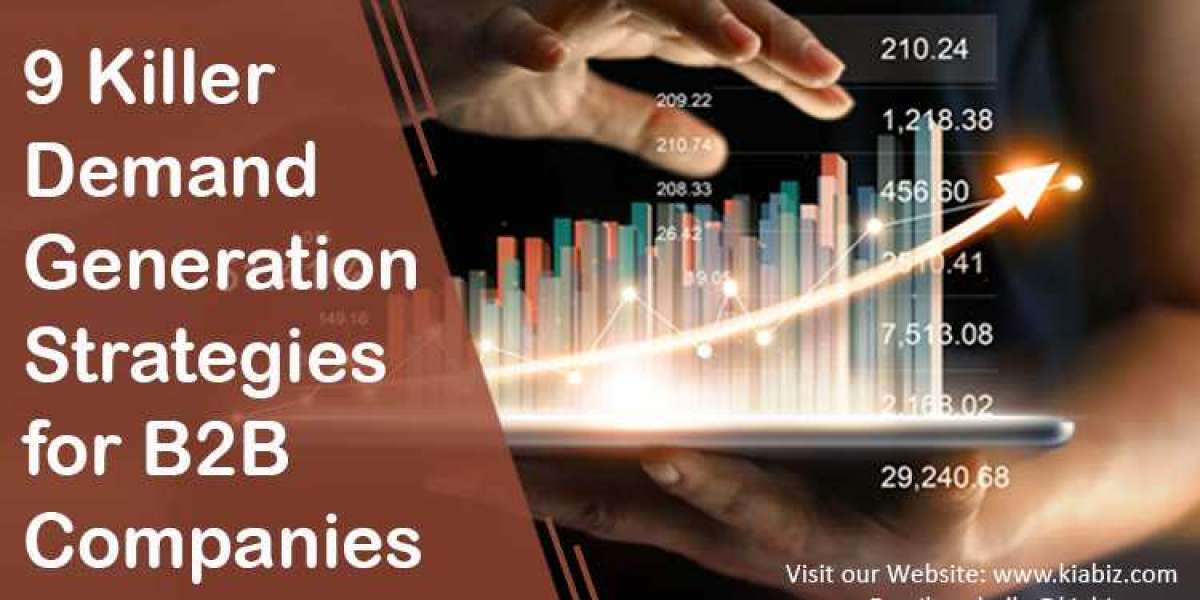Demand generation is a marketing strategy that focuses on targeting qualified leads by educating them, addressing their pain points, and offering solutions through your product or service. Demand generation requires a joint effort from multiple business teams to attract more leads and make them interested in becoming paying customers.
B2B demand generation is especially challenging in today’s competitive and complex market. B2B buyers are more informed, more demanding, and more selective than ever before. They have access to a plethora of information online and they expect personalized and relevant interactions from vendors. According to Gartner, the average B2B buying group involves 6 to 10 decision-makers who spend 15% of their time on researching solutions.
So how can you stand out from the crowd and generate demand for your B2B product or service? Here are 9 killer demand generation strategies that you can use to boost your B2B marketing efforts.
- Create high-quality content that educates and engages your audience
Content is the backbone of any demand generation strategy. Content helps you build brand awareness, establish industry expertise, and nurture leads through the buyer’s journey. Content can take many forms, such as blog posts, ebooks, whitepapers, case studies, webinars, podcasts, videos, infographics, etc.
The key to creating effective content is to understand your buyer persona and their pain points, challenges, goals, and preferences. You need to create content that answers their questions, provides valuable insights, and showcases your unique value proposition. You also need to optimize your content for search engines and social media platforms to increase your visibility and reach.
- Implement account-based marketing (ABM) to target high-value accounts
Account-based marketing (ABM) is a demand generation strategy that focuses on targeting specific accounts that are most likely to buy from you. ABM involves identifying key decision-makers within those accounts, creating personalized messages and campaigns for them, and aligning your sales and marketing teams to deliver a consistent and tailored experience.
ABM can help you increase your conversion rates, shorten your sales cycles, and improve your customer retention. According to ITSMA, 87% of marketers say that ABM delivers higher ROI than other marketing activities. ABM can also help you build stronger relationships with your existing customers and upsell or cross-sell them more effectively.
- Leverage social media to amplify your brand voice and connect with your audience
Social media is a powerful tool for demand generation. Social media allows you to showcase your brand personality, share your thought leadership, engage with your prospects and customers, and drive traffic to your website or landing pages. Social media can also help you generate leads by using paid ads, organic posts, live videos, stories, polls, quizzes, etc.
The key to using social media for demand generation is to choose the right platforms for your audience, create relevant and engaging content for each platform, and monitor and measure your performance. You should also use social listening tools to track what people are saying about your brand, industry, competitors, and topics of interest. This can help you identify opportunities for engagement, feedback, and improvement.
- Use email marketing to nurture leads and drive conversions
Email marketing is one of the most effective demand generation strategies. Email marketing allows you to communicate with your leads and customers in a personalized and timely manner. Email marketing can help you educate your audience about your product or service, provide value-added content or offers, build trust and credibility, and encourage them to take action.
The key to using email marketing for demand generation is to segment your email list based on various criteria such as industry, company size, role, stage of the buyer’s journey
- Optimize your website and landing pages for conversions
Your website and landing pages are the main destinations for your demand generation campaigns. They are where you showcase your product or service, capture your leads’ information, and persuade them to take the next step. Therefore, you need to optimize your website and landing pages for conversions.
Some of the best practices for optimizing your website and landing pages are:
- Use clear and compelling headlines and subheadlines that capture your value proposition and address your audience’s pain points.
- Include relevant and engaging images, videos, or animations that illustrate your product or service benefits and features.
- Use testimonials, case studies, or social proof to build trust and credibility.
- Provide clear and concise copy that highlights your unique selling points and differentiators.
- Use strong and specific calls to action (CTAs) that tell your visitors what to do next and why.
- Use lead magnets such as ebooks, whitepapers, webinars, etc. to offer value in exchange for your visitors’ contact information.
- Use forms that are easy to fill out and ask only for the essential information.
- Use A/B testing tools to experiment with different elements of your website and landing pages and see what works best.
- 6. Run paid advertising campaigns to reach your target audience
Paid advertising is a demand generation strategy that involves using platforms such as Google Ads, Facebook Ads, LinkedIn Ads, etc. to display your ads to your target audience based on their keywords, demographics, interests, behaviors, etc. Paid advertising can help you increase your brand awareness, generate more traffic, and drive more leads.
The key to using paid advertising for demand generation is to:
- Define your goals and budget for each campaign.
- Choose the right platforms and formats for your audience and message.
- Create relevant and engaging ads that match your audience’s intent and stage of the buyer’s journey.
- Use landing pages that are consistent with your ads and offer a clear value proposition and CTA.
- Track and measure your results and optimize your campaigns accordingly.
- Partner with influencers or industry experts to expand your reach
Influencer marketing is a demand generation strategy that involves collaborating with influencers or industry experts who have a large and loyal following on social media or other platforms. Influencer marketing can help you increase your brand awareness, credibility, and trust among your target audience. Influencer marketing can also help you generate more leads by leveraging the influencer’s endorsement, recommendation, or referral.
The key to using influencer marketing for demand generation is to:
- Identify the right influencers or industry experts for your niche, audience, and goals.
- Build a genuine relationship with them and offer them value in exchange for their collaboration.
- Co-create content or campaigns that are relevant, authentic, and engaging for both their audience and yours.
- Monitor and measure the impact of your influencer marketing efforts and adjust your strategy as needed.
- Host or attend events to connect with your prospects and customers
Events are a demand generation strategy that involves hosting or attending physical or virtual events such as trade shows, conferences, seminars, workshops, webinars, etc. Events can help you showcase your product or service, educate your audience, network with potential customers or partners, and generate more leads.
The key to using events for demand generation is to:
- Choose the right events that align with your goals, audience, and budget.
- Plan ahead and prepare your materials, presentations, demos, etc.
- Promote your events through various channels such as email, social media
- Use analytics and feedback to measure and improve your demand generation efforts
Demand generation is not a one-time activity, but a continuous process that requires constant monitoring, measurement, and improvement. You need to use analytics and feedback tools to track and evaluate your demand generation performance and identify what works and what doesn’t.
Some of the metrics that you should track and analyze are:
- Traffic: The number of visitors to your website or landing pages from various sources and channels.
- Leads: The number of visitors who provide their contact information or express interest in your product or service.
- Conversion rate: The percentage of visitors who complete a desired action such as filling out a form, downloading a resource, requesting a demo, etc.
- Cost per lead: The amount of money spent on generating each lead.
- Lead quality: The relevance and readiness of each lead for your product or service.
- Lead nurturing: The process of engaging and educating your leads until they are ready to buy.
- Sales cycle: The length of time it takes for a lead to become a customer.
- Customer acquisition cost: The amount of money spent on acquiring each customer.
- Customer lifetime value: The amount of revenue generated by each customer over their relationship with your business.
You should also collect feedback from your prospects and customers through surveys, interviews, reviews, testimonials, etc. to understand their needs, preferences, expectations, satisfaction, and loyalty. This can help you improve your product or service, content, messaging, and overall customer experience.
Conclusion
Demand generation is a vital strategy for B2B companies that want to grow their business and stay ahead of the competition. Demand generation can help you attract more qualified leads, nurture them through the buyer’s journey, and convert them into loyal customers.
To implement a successful demand generation strategy, you need to use a combination of tactics such as content marketing, ABM, social media marketing, email marketing, paid advertising, influencer marketing, events marketing, and analytics and feedback. You also need to align your sales and marketing teams and provide them with the right tools and resources to execute your demand generation plan. By following these 9 killer demand generation strategies for B2B companies, you can boost your brand awareness, authority, and trust among your target audience and generate more demand for your product or service.
WHY KIA Biz
Over the course of our more than eight years in business, KIA Biz has worked with clients from all over the world. We have helped our clients accomplish their objectives using effective account-based marketing.
Through highly targeted contact discovery operations, we identify the precise stakeholders in big enterprises, work with them to build hyper-personalized content, and then produce leads for them.
You can reach prospects wherever they are with KIABIZ by adding value at each stage of the purchasing process. If you want effective Contact Discovery, Lead Generation, and Account-Based Marketing, email us at hello@kiabiz.com, We are prepared to assist. Visit our website for additional information: https://www.kiabiz.com








